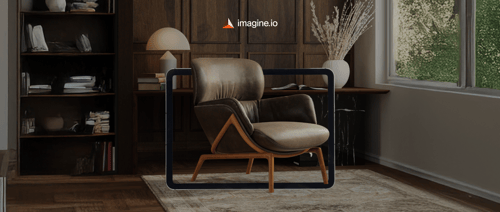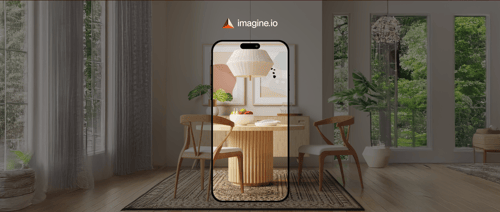Visual merchandising has evolved from being an aesthetic afterthought to a core revenue-driving function. In today’s fast-paced retail landscape, your in-store experience must be as agile as your marketing campaigns. And that’s exactly where automated 3D planning tools are changing the game. These tools don’t just make your layouts look better—they make your teams work smarter, execute faster, and deliver more consistent results across locations.
If you’re a retail executive still relying on static mockups, paper planograms, or costly physical prototypes, you’re not just working harder—you’re falling behind. Let’s walk through why high-performing visual merchandising teams are embracing automation, and how it’s reshaping retail at scale.
Get the latest updates straight to your inbox.
By clicking sign up you'll receive occasional emails from imagine.io. You always have the choice to unsubscribe within every email you receive.
Faster Planning, Smarter Execution
Manual planning is slow, repetitive, and vulnerable to human error. Creating a new store layout or updating an existing one often involves weeks of back-and-forth between merchandising, store ops, and design.
Automated 3D tools remove this friction. Visual merchandising teams can design and iterate store layouts in real time. Need to adjust for a new seasonal launch or regional product mix? It can be done in hours—not days. That speed to execution allows teams to stay ahead of trends and respond swiftly to market demands.
One Platform, Global Consistency
Enterprise retail brands often face one major challenge: consistent execution across hundreds—or even thousands—of store locations. Physical mockups and PDF planograms can be misinterpreted at the store level, leading to brand inconsistencies.
With automated 3D planning tools, every stakeholder works off the same centralized, visual environment. From head office to store staff, everyone can access and interact with accurate, photorealistic layouts. This single source of truth ensures the brand experience remains consistent—whether you’re walking into a flagship in New York or a mall store in Dallas.
Fewer Errors on the Sales Floor
Traditional merchandising relies heavily on written instructions and flat diagrams. But what happens when store staff misread them? Poor shelf placement, inefficient navigation paths, and cluttered displays become common problems. Automated 3D tools eliminate ambiguity.
Teams can virtually walk through the space, see how every element fits together, and understand exactly what needs to be built. This dramatically reduces execution errors and cuts down on costly corrections post-setup.
Data-Backed Design That Converts
In retail, every square foot counts. But how do you know which product should go where? With automated 3D planning tools, visual merchandisers can simulate store layouts and analyze how design decisions impact shopper behavior.
Combine these layouts with POS data, and you can identify high-performing zones, optimize endcaps, and refine product placement to maximize sales. You’re no longer relying on gut feel—you’re making informed decisions rooted in data.
Lower Costs, Higher Impact
Building physical prototypes for new visual concepts isn’t just time-consuming—it’s expensive. You pay for materials, labor, and warehouse space just to test ideas.
With automated 3D planning tools, you design, visualize, and refine store concepts digitally. These tools let you render near-photographic layouts that can be reviewed by cross-functional teams, all without leaving your desks. This not only cuts costs but speeds up the entire planning cycle.
Seamless Cross-Team Collaboration
Effortless Scenario Testing
Innovation Without the Risk
Where imagine.io Comes In
At imagine.io, we’ve helped retail teams of all sizes make this shift. Our platform brings together automation, high-fidelity 3D rendering, and cloud-based collaboration to help visual merchandising teams do more with less. With no need for technical 3D expertise, your team can start building store layouts that are both functional and visually compelling—fast.
Whether you manage 20 stores or 2,000, imagine.io makes scaling visual merchandising simple, smart, and effective.
Conclusion: Step Into the Future of Visual Merchandising
Visual merchandising is no longer just about product placement—it’s about precision, performance, and scalability. Automated 3D planning tools give your teams the speed, clarity, and confidence to execute flawlessly across every store. If your merchandising workflow is still stuck in the past, now is the time to upgrade.
The most successful brands are already planning in 3D. Are you?
Book a Free Demo Today! Experience how imagine.io can help your visual merchandising team thrive—without the complexity.


.gif?width=1296&height=1296&name=Untitled%20design%20(8).gif)



.png?width=500&name=How%20to%20Add%20a%203D%20Product%20Configurator%20to%20Your%20WordPress%20Website%20(Complete%20B2B%20Guide).png)
















%20(1).png?width=500&name=Why%20Exploded%20Mattress%20Views%20Matter%20(And%20How%20to%20Generate%20Them)%20(1).png)
.png?width=500&name=Best%20Shopify%20Product%20Configurator_%20How%20to%20Choose%20the%20Right%20One%20(2).png)
.png?width=500&name=Why%20Exploded%20Mattress%20Views%20Matter%20(And%20How%20to%20Generate%20Them).png)



.png?width=500&name=Best%20Shopify%20Product%20Configurator_%20How%20to%20Choose%20the%20Right%20One%20(1).png)







.png?width=500&name=How%203D%20Rendering%20Can%20Make%20or%20Break%20Your%20Industrial%20Design%20Pitch%20(1).png)








%20with%20Digital%20Twins%20and%203D%20Visualization.png?width=500&name=Optimizing%20Your%20Digital%20Asset%20Management%20(DAM)%20with%20Digital%20Twins%20and%203D%20Visualization.png)




.png?width=500&name=Styling%20Home%20Decor%20for%202025_%20From%20Global%20Influences%20to%20Playful%20Personalization%20(1).png)

